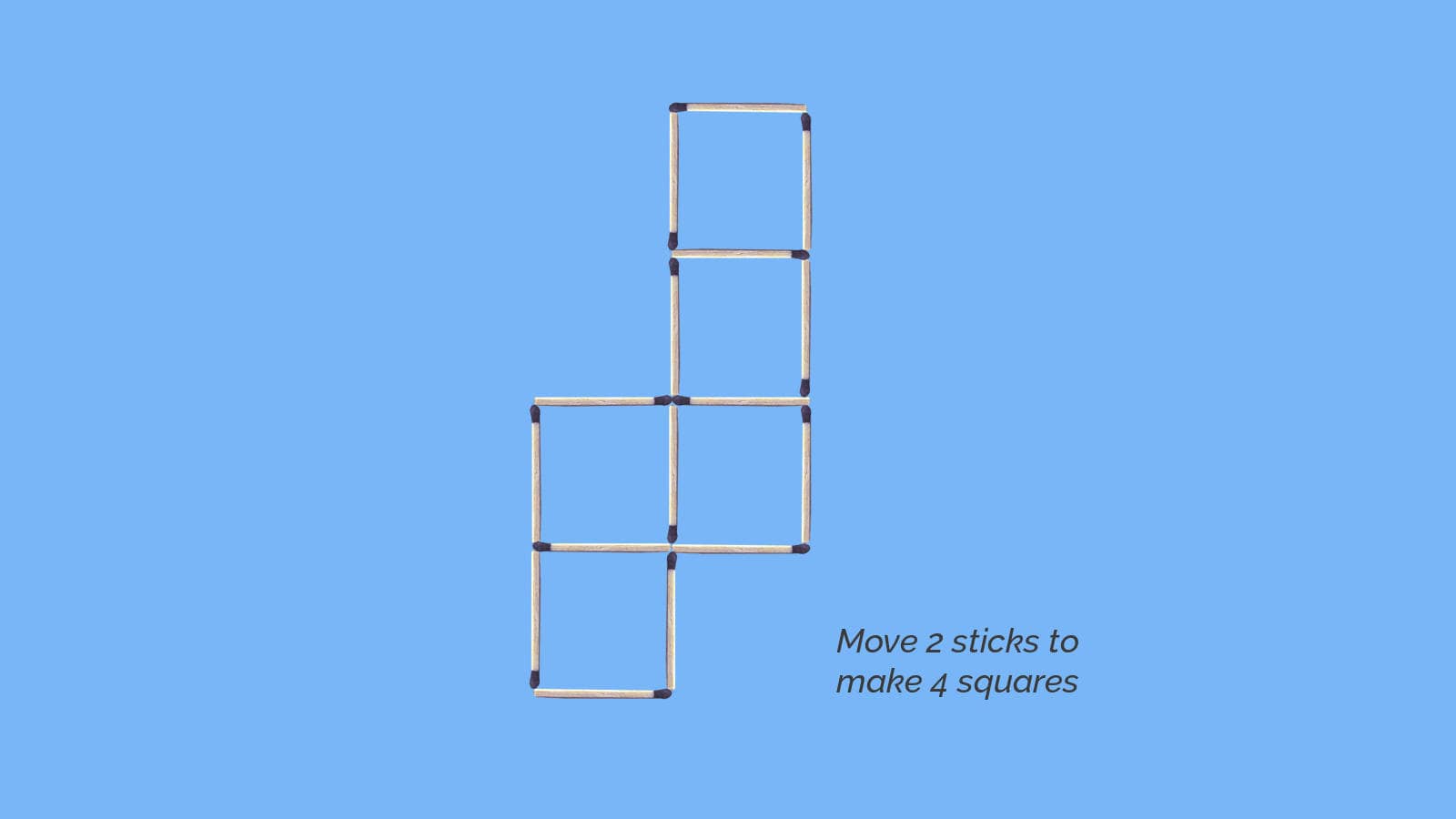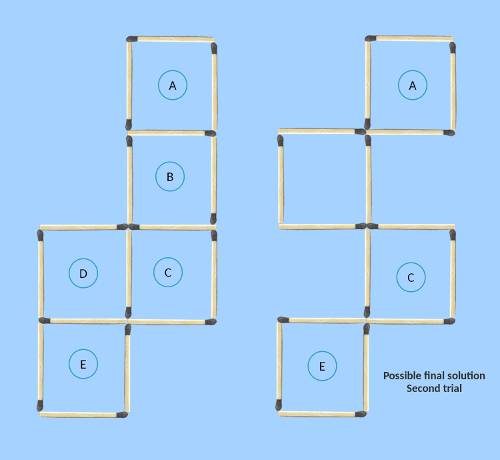
Move 2 matches to make 4 squares matchstick puzzle
Move 2 matches to make 4 squares in the matchstick puzzle figure.

All 4 squares will be of the same size with no matchstick hanging. Each matchstick must be a side of a square.
How many solutions can you find?
Recommended time to solve: 20 minutes.
Try. It will be fun.
We will solve the puzzle in two different ways,
- First quick solution based on question, analysis and answer to solve finally by the End state analysis approach.
- Solution by direct use of the End State analysis approach.
First Solution: Move 2 matches to make 4 squares matchstick puzzle: by Question, analysis and answering technique
With a systematic approach, we will raise appropriate questions, analyze and then make a conclusion.
This process will gradually home in to the solution in least number of steps.
The puzzle figure shown.

The first step, jot down what is known,
- 5 similar squares make the puzzle figure,
- 16 matchsticks are used in making the figure, and,
- In the puzzle figure, 4 matchsticks are common between two squares.
Identification and analysis of common sticks are important in solving matchstick puzzles.
First question that we ask ourselves,
Question 1: What about the final figure?
What are its characteristics?
How would it look?
Answer is,
Conclusion 1: Four squares, 1 square less than the puzzle figure, will make the solution figure.
The same 16 matchsticks used in the final 4 square figure.
Based on this knowledge the second question follows,
Question 2: When 16 sticks make 5 squares in the puzzle, how can the same 16 sticks will make four squares in the solution?
Will there be any common sticks?
If we get a clear answer to this question we would get a good idea about our target figure.
In answer, conclusion is easy,
Conclusion 2: The four squares in solution will be independent squares with no common stick between them. A single common stick would have reduced the number of sticks required to 15.
16 matchsticks would be enough to make these four independent squares.
This is a key pattern discovery.
Common stick concept
The figure below makes the common stick concept clear.

On the left, 8 matchsticks make two independent squares.
But on the right, when these two have one common stick, 15 matchsticks are enough to make two squares.
The common stick serves the role of a side of BOTH THE SQUARES.
So the next question raised is,
Question 3: How many ways can 16 matchsticks make the four independent squares?
Realization: If UNCONNECTED to each other, four independent squares can be in UNCOUNTABLE formations. Two possibilities are shown in figure.

This helps to make the next conclusion,
Conclusion 3: The four independent squares must be connected at the corners if they are to be formed by 16 matchsticks of the puzzle figure.
Otherwise, it is all uncertainty and there will be no solution.
With this extra condition, it is easy to see that there can only be three possibilities as shown.

A vertical line of symmetry is drawn through the centers of three possible final figures and the puzzle figure.
This should help understand how far apart the squares are.
Comparison of the three final figures with the puzzle figure: Move 2 matches to make 4 squares matchstick puzzle
The Key pattern identified,
In both the possible final figure 1 and 3, one square on each side of the vertical line of symmetry is separated from the line of symmetry by one full square.
But in the puzzle figure, all the squares are attached to the line of symmetry.
It follows,
Conclusion 4: These two possible final figures are too much different from the puzzle figure to make in 2 stick moves.
The only possible figure that have to be the solution is the possible final figure 2.
The last question is simply,
Question 3: which two sticks are to be moved to form the solution figure 2 in the middle?
It takes just a brief analysis to identify the two sticks that are to be moved to form the solution figure shown.

Now we will use the same End state analysis approach without the reasoning part but with the knowledge of how to use the method.
2nd Solution: Move 2 matches to make 4 squares matchstick puzzle: By direct application of End state analysis approach
The key pattern and requirement in the final solution figure is,
The given 5 squares have 16 sticks that are just enough for exactly 4 squares. So in the final figure, there can’t be any common side between any two squares.
To convert the initial puzzle to this final figure, we will first form possible final figures.
We will then compare each possible final figure with the puzzle figure to know how much similar the two figures are.
Comparison between possible final figures with puzzle figure: Move 2 matches to make 4 squares matchstick puzzle
First trial is shown below with puzzle figure on the left and a possible final figure on the right.

The squares in the first possible final solution are spread out and separated quite a bit horizontally.
This figure is very dissimilar with the puzzle figure. In 2 stick moves, no way can we convert the puzzle figure to this possible final figure.
This conclusion is based on visual assessment.
If you place one figure on the other, you would find only the two squares B and D common between the two.
In the second trial, we would make the possible final figure much more compact.
It is shown.

Here, the common squares between the initial and final figure are 3, square A, C and E.
As this figure is similar with the puzzle figure to the greatest extent, it must be the final solution. Greatest similarity ensures least number of stick moves.
It is easy to identify the two sticks to move for creating a new square, as shown in the first solution.
This approach gives you the quickest solution. It is one of the most powerful general problem solving approaches.
Number of solutions
Question: is there any more solution figure?
You need to convince yourself that the solution figure in this case is unique.
End note
The two solutions are similar. Both finally uses the same End state analysis approach of comparing possible final solutions with the puzzle figure.
In the first case, a series of question and answer lead to applying End state analysis.
In the second case, the End state analysis approach has been applied directly at the start itself.
The method of problem solving by asking a series of questions, analyzing and making conclusions, step by step is a general systematic problem solving approach.
Its scope of application is wider than the End state analysis approach.
Both approaches are powerful general analytical methods suitable for solving many types of problems, including real life problems.
These solutions, though, are quick and elegant with no trial and error, you gain little insight into the puzzle structure or the two stick moves.
In fact, bypassing the details of the problem contributed most towards the elegance and speed of the solution.
In contrast, solving this same matchstick puzzle by stick move analysis takes longer, but imparts thorough knowledge on various aspects of the puzzle. That’s an inevitable trade-off.
Your challenge: Solve the puzzle without using the End state analysis approach.
To get an idea of how a similar matchstick puzzle can be solved purely by analysis of the puzzle figure and the solution requirements, go through the first part of the matchstick puzzle solution,
Matchstick puzzle, 5 squares to 4 squares in 3 moves.
Last, to solve matchstick puzzles you don’t need to know maths or any other subject—you have to identify key patterns and use reasoning to reach the solution with confidence and speed.
Know how to solve difficult problems easily without wasting time on random attempts
Our ebook on puzzle solutions by innovative methods will show you just that.
Puzzles for Adults: 50 Brain Teasers with Step-by-Step Solutions: Boost Your Power of Problem Solving
BUY the eBook Amazon Kindle version here, from Google Play here and Paperback here.
Second book on Innovative Solutions to Matchstick Puzzles from Suresolv

BUY Creative Matchstick Puzzles Innovative Solutions eBook Amazon Kindle version
BUY the paperback here.
Puzzles you may enjoy
Easy to hard brain teasers with systematic solutions
Challenging brain teasers with solutions: Long list.
This will always be the most up-to-date full list with the brain teasers classified into categories that can be browsed separately.
You may also click on the category term link below to enjoy the brain teasers that are classified in the present category.
For example, if the category term link shown below is "Riddle", click on it to go through all the Riddles.
